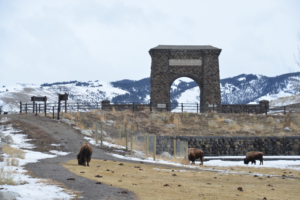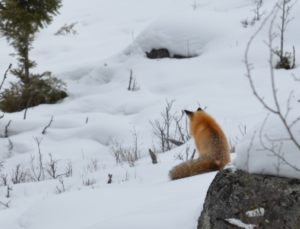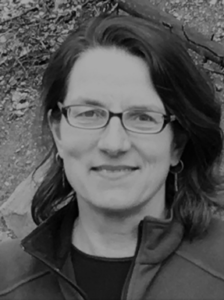By Nedra Chandler
“Winter use in Yellowstone National Park is, at root, a conflict over deep public values…”
–Mike Yochim, member of Yellowstone Grand Teton Winter Use team,and author of
Yellowstone and the Snowmobile, Locking Horns Over National Park Use (2009)
 Winter in Yellowstone, the world’s first National Park, is unforgettable.
Winter in Yellowstone, the world’s first National Park, is unforgettable.
Visiting in February with my husband and friends, we watched two wolves resting together on a hillside in the Lamar Valley. We skied past bison going up Slough Creek, using their huge shaggy heads to browse in the snow. As we began a climb, a woodpecker’s staccato broke the silence. A fox sat quietly with its back to us beside the trail. Later after a hot soak in the Boiling River near Gardiner, we went back to the Mammoth Hotel to have dinner and listen to an evening Ranger talk upstairs.
 Winter season in Yellowstone wasn’t always so serene. Just 20 years ago, the park was struggling with the so-called “Yellowstone snowmobile dispute.” The situation held sharply-divided views of public rights and public responsibilities in using, while also protecting, public lands. How should Yellowstone and Grand Teton National Parks be used in the winter? That was the question at the heart of serial public conflicts over a period of more than 80 years in Yellowstone.
Winter season in Yellowstone wasn’t always so serene. Just 20 years ago, the park was struggling with the so-called “Yellowstone snowmobile dispute.” The situation held sharply-divided views of public rights and public responsibilities in using, while also protecting, public lands. How should Yellowstone and Grand Teton National Parks be used in the winter? That was the question at the heart of serial public conflicts over a period of more than 80 years in Yellowstone.
Thanks to a small group of government pros
One main reason the situation started moving in a better direction was because of a small, committed group of National Park Service leaders and staff in Yellowstone and Grand Teton (NPS team) who banded together to guide the work with integrity, and in the collective public interest. The NPS team listened to commenters from around the globe, and they carefully braided the best available science into policy. “Now it feels like a National Park again,” says NPS Ranger Joe Beuter, a three-decade veteran of Yellowstone, in his evening talk at Mammoth Hotel I attended last month. “Now winter use is working. And it’s because of the people who got this plan in place and all the citizens who commented and made their voices heard.”
Get notified when new articles are posted to the EDR blog – sign up for our email list »
“My clothes stunk of exhaust”
In his talk, Beuter reflected back on his winters in Yellowstone, recalling the late 1980s and “roaring ‘90s” when use of the park was less actively managed. “It was 7 days a week all season,” Beuter recalled, “we saw up to 2000 sleds in here a day and those days it felt like trying to hold back the ocean.” Imagine the daily occurrence when snowmobilers would start up their engines en masse after lunch at Old Faithful. Beuter recalls, “The noise and haze was so thick you couldn’t see the ranger station from the visitor center. My clothes stunk so bad of exhaust my wife asked me to just leave them in our garage at night.”
Maintaining order was difficult—visitors questioned the validity of tickets for off-roading when there were near-by sledders doing it too. Alcohol use only fueled the mayhem, and there was always at least one accident a day. The noise and air pollution, crowding, impact on wildlife, and health and safety concerns of employees and visitors were only getting worse. Visitor satisfaction survey ratings plummeted. The roads were overused and the resulting washboard bumps made driving difficult and uncomfortable. Many said to Park concessionaires, “never again.” Yet new crowds showed up each winter anyway.
Courage, commitment, building agreement on public policy
Something had to be done, but the question was: What? Naturally, people disagreed. Unfortunately, many took polar opposite sides. Some insisted on continued unfettered use, as if taking the line from the Woody Guthrie song, “this land is our land” literally. Others imagined a ban on snowmobile use.
As usual, the polarized narratives supporting each camp overlooked nuance and important insights that the law, regulations, research, innovations and other experience offered at the time. Angry accusations flew. Four lawsuits were filed against the government in two Federal courts in Wyoming and Washington, D.C. NPS officials had to show up frequently in both courts. The public conversation seemed polarized and stuck.
I witnessed this juncture first hand with two of my favorite colleagues/friends: Martha Bean and Nicholas Dewar. Together we served as third-party process experts for winter use connected to NEPA in Yellowstone and also Grand Teton National Park. My first task was to carry out a situation assessment to discern what kind of engagement government cooperators and the public were ready for. Then we helped design and facilitate the work that followed from 2005 to 2010.
Clear & doable ‘promise to the public’ and to government cooperators
The NPS team anchored their work with a clear (and doable) promise to the public. They made the same promise to their governmental cooperators and jointly signed a memo of understanding to clarify. It was not a promise to use a consensus building process to develop a consensus outcome since the whole range of interviewees in the assessment had agreed that was not ripe to carry out at the time. The NPS promise was “we want to hear from you, we will listen, and we will let you know where we used or didn’t use your comments in the Record of Decision.”
While the National Environmental Policy Act (NEPA) process helped create a deliberative space to develop a new policy and rulemaking, it wasn’t always clarifying. The same was true of the ongoing litigation and media coverage. With all of this happening concurrently, it tended to amp up drama and confusion. The complex issues around winter use were too often reduced to “the Yellowstone snowmobile dispute.”
How was the conflict managed and brought to a more workable situation?
Resolution leaned on that small team of courageous, committed government professionals—with Yellowstone and Grand Teton at the center. All were able to intentionally avoid taking hard positions and becoming polarized themselves. This allowed them to keep moving the significant work forward, bit by bit.
For the NEPA process, NPS recruited and relied on key partners. For example, they worked with seasoned NEPA and U.S. Environmental Protection Agency experts and closely with forest supervisors who managed the land adjacent to the parks.
In the background, all along, the NPS took its federal trust responsibility to sovereign tribes seriously in government-to-government talks. NPS also stayed in equitable touch with the three states (Wyoming, Montana and Idaho), members of Congress, county governments and many other stakeholders.
Together the Park-level NPS team forged the basis for the Record of Decision and the Rule adoption that was later embodied in an adaptive management program for Yellowstone in the winter of 2012-13. It works. I understand the annual visitation in 2017 to Yellowstone in all seasons topped 4.2 million for the first time ever. In light of that big number, the winter experience is especially precious and noteworthy.
No one is more pleased than Park Ranger Joe Beuter. “Now, visitors on guided, quieter snowmobiles with the best available technologies and emission controls, stop to take photographs of wildlife and scenery from a respectful distance. In my formative winter seasons, it was more common to see sleds chasing wildlife at high speed,” Beuter recalled.
“Transcend and include”
Winter use management in Yellowstone was developed by public servants employing a coherent public decision-making process after nearly a century of serial conflicts. The process had integrity baked into it because it was directly connected to the integrity of the team itself. They listened and then created the package of actions now being carried out in a science-based, systematic yet adaptive ways.
In the adult development field, we have a phrase, “transcend and include.” Instead of this OR that, good OR bad, win OR lose, right OR wrong, you notice this AND that. The Yellowstone winter-use conflict resolution bridged the “or” with a powerful “and”—the public right and public responsibility when it comes to using public lands. And it’s lovely to notice the peace that reigns much more frequently there in winter these days. Maybe the transcend-and-include approaches that worked in Yellowstone could be applied to bridge the political divides and hyperpolarized public conversations in our nation today — and let more patience and peace reign beyond the Parks.
 Nedra Chandler: I am a professional facilitator/mediator guide and development coach for individuals, teams, and intergovernmental work. My favorite work is supporting the promise and possibilities present in every situation by helping people discern for themselves what they are ready for next. Find me at Cadence and at Triangle Associates. Please do sign up to receive my monthly posts here. I would like to hear from readers on my thoughts and views. Please send to cadence@montana.com.
Nedra Chandler: I am a professional facilitator/mediator guide and development coach for individuals, teams, and intergovernmental work. My favorite work is supporting the promise and possibilities present in every situation by helping people discern for themselves what they are ready for next. Find me at Cadence and at Triangle Associates. Please do sign up to receive my monthly posts here. I would like to hear from readers on my thoughts and views. Please send to cadence@montana.com.
